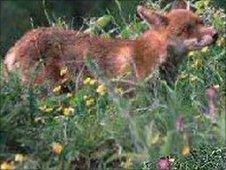Threat to Derbyshire's wildlife sites
- Published

A report to the trust highlighted the problems
Wildlife sites across Derbyshire are facing a difficult future and will continue to decline unless urgent action is taken, experts say.
A report by Derbyshire Wildlife Trust said poor management of wildlife sites, intensive agricultural practices and pond infilling had take its toll.
The trust said 130 sites had been lost since 1984 and more than 50 were still under threat.
And the report said less than a quarter of the 50 sites were in good condition.
The report points out that local wildlife sites do not get the same level of legal protection as national nature reserves or Sites of Special Scientific Interest, but many were "just as important for wildlife".
The trust recently completed a 10-year study of local wildlife sites across the county.
And the document highlights more than 1,000 sites in Derbyshire outside the Peak District National Park covering more than 10,000 hectares, or 6% of the county.
They contain important wildflower meadows, grasslands, ancient woodlands and ponds - all of which are valuable habitats for species that are declining locally or nationally.
These include water voles, many moth species, plants such as orchids and reptiles and amphibians.
Their numbers, and the wildlife they contain, says the report, make them the best way of assessing the state of the county's environment.
Trust chief executive Ed Green said: "Behind Derbyshire's natural beauty it is clear that all is not well.
Local wildlife sites are the cornerstones of the county's landscape, and in many cases are the last refuges for vulnerable animals and plants.
"We all stand to lose out if we don't take action - a thriving natural environment is important not only for our wildlife but for everyone's physical and mental well-being.
"Healthy landscapes also help protect against flooding and pollution."
Mr Green added the trust was working with landowners and other partners to restore landscapes.